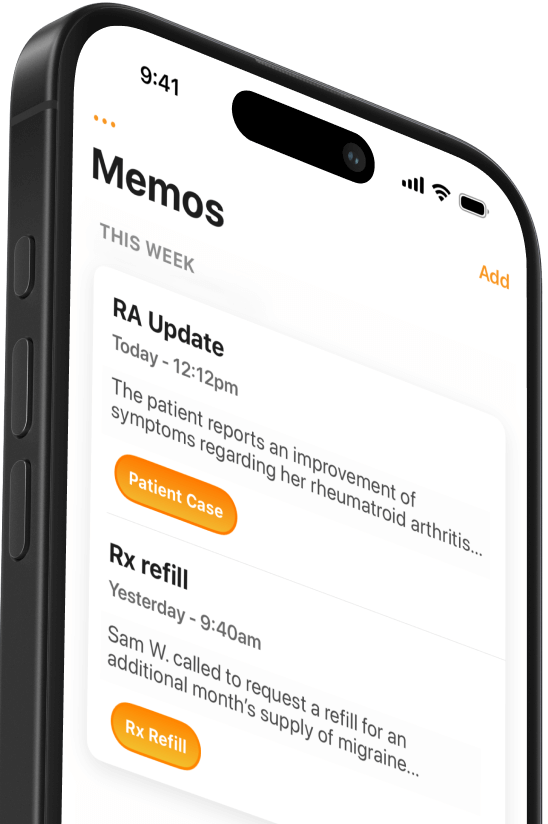What are EHR templates?
Templates streamline documentation, improve patient care, standardize data, and reduce under-billed appointments.


Popular articles
<p id="">Electronic Health Record (EHR) templates are pre-structured digital forms that help healthcare providers document patient encounters quickly and consistently. EHR templates help streamline data entry with predefined fields, drop-down menus, and text boxes so doctors can <a href="https://mobius.md/2022/05/18/doctors-should-stop-typing/" id="">type less</a> and quickly complete notes that comply with clinical and billing standards.</p><p id="">Providers who used early template-based documentation solutions might associate them with over-documentation or overly formulaic notes. But a lot has changed in recent years. Most EHR templates are now customizable and AI is playing a bigger role. If you’ve written off templates in the past, it could be worth taking a second look. </p><p id="">In this article, we’ll start with some examples of templates before exploring how they’ve evolved—and why they’re still a powerful approach to clinical documentation.</p><h2 id="">Examples</h2><p id="">EHR templates vary widely depending on the type of visit and medical specialty. Here are some common examples:</p><ul id=""><li id=""><strong id="">SOAP Note</strong>—Carried over from pre-digital documentation to EHRs, the <a href="https://mobius.md/2024/11/13/step-by-step-guide-to-taking-perfect-clinical-notes/" id="">SOAP format</a> is still a popular way to structure notes. </li><li id=""><strong id="">Specialty-Specific</strong>—Most vendors include a menu of EHR templates for different medical fields, such as dermatology templates for lesion tracking or cardiology templates for EKG interpretations.</li><li id=""><strong id="">Procedure</strong>s—Template libraries also typically include templates for documenting common procedures, such as vaccinations, joint injections, or minor surgeries.</li><li id=""><strong id="">Follow-up Visit</strong>s—Instead of repeating details from a past visit at a follow-up visit, these templates pre-fill key patient details to make routine visits more efficient.</li></ul><h2 id="">How EHR Templates Have Changed</h2><p id="">Many physicians found early EHR templates frustrating. The chief complaint was that templates were too rigid, forcing providers to fit their workflow into discrete data fields that someone else thought were important. Providers also worried that templates led to generic, copy-paste notes that filled the chart with too much text, making it harder to read in the future.</p><p id="">Fortunately, vendors have made templates more flexible and customizable since the early days. Specialty-specific templates are now the regular starting point for most providers. Users can further customize their templates by modifying fields, adding frequently used phrases, and removing irrelevant sections.</p><p id="">AI is taking EHR templates to a new level by learning from past encounters and adapting them to match physician workflows better. For example, <a href="https://www.epic.com/" id="">Epic’s EHR</a> uses predictive text and auto-population to suggest relevant fields based on patient history and provider habits. As AI technology improves and becomes more integrated into EHRs, we can expect even smarter templates that further reduce documentation time with a more personalized workflow.</p><h2 id="">Benefits of Using EHR Templates</h2><p id="">The biggest benefit of EHR templates is efficiency. By reducing manual typing, templates help providers complete documentation faster and spend more time with patients. The newest AI-driven EHRs use features like auto-suggested fields to make documentation even quicker. </p><p id="">In addition to saving time, templates can improve accuracy and ensure notes meet clinical and billing requirements. Standardizing data entry also improves interoperability between different EHR systems. </p><p id="">Most users will need to use a new set of templates for a few weeks before experiencing substantial efficiency gains. If you're still not saving significant time, check out these tips for <a href="https://mobius.md/2023/05/22/how-to-improve-your-ehr-templates/" id="">making the most of your EHR templates</a>.</p>
Related Articles


We Get Doctors Home on Time.
Contact us
We proudly offer enterprise-ready solutions for large clinical practices and hospitals.
Whether you’re looking for a universal dictation platform or want to improve the documentation efficiency of your workforce, we’re here to help.





